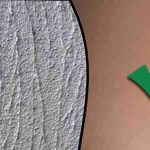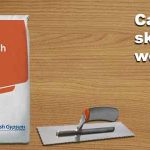Plastering is a highly skilled job, and to achieve the perfect finish, it’s vital that all surfaces are prepared correctly.
Plaster needs to form a solid bond to the subsurface. For this to occur, the surface must be in good condition and provide a decent key, which will allow the plaster to adhere correctly. This will ensure the plaster gets a good hold and doesn’t fall away from the wall.
It is possible to skim over wallpaper, but it is not recommended. If the wallpaper is fixed firmly to the wall with no bubbles or loose sections, then the plaster will bond. However, there is a risk that the paper and plaster could come lose, so this is not considered a good approach.
When skimming over wallpaper, the moisture in the plaster could be absorbed by the paper. This can eventually cause the wallpaper and paste to soften and loosen, increasing the risk of it coming away from the wall. It could also cause problems with the plaster going off, meaning it could affect the plasters drying process.
Can you skim over woodchip?

It can seem tempting to apply plaster over surfaces, rather than removing them. This is especially true if the removal of an existing surface is a big job. A good example of this would be woodchip.
Woodchip is known to be difficult to remove, which might make you consider plastering over. However, the recommendation is to remove woodchip where possible.
Should you opt to plaster over woodchip, you will need to prime the surface which will give the plaster the ability to bond to it. You can do this by applying something like blue grit to the surface of the woodchip. This will create a primed surface, that makes it easier for the plaster to bond to.
How long the skim coat of plaster lasts will depend on the woodchip. If the woodchip fails and starts to come away from the wall, the plaster will come away with it. As there is always a risk of this happening, it is recommended that you just bite the bullet and strip the walls.
Yes, it is a tedious job, but doing it right should mean you only need to do it once.
Can you skim over wallpaper on a ceiling?
There are some instances where you might find wallpaper on a ceiling. This is an area where you really should put in the extra effort and get it stripped off.
When you apply plaster to a ceiling, there are forces involved. Naturally, gravity is going to pull the plaster downwards and this is where you could experience a problem with plastering over paper on a ceiling.
In the same way as wallpaper on walls, the wallpaper could suck some of the moisture out of the plaster. This could soften the wallpaper, which could cause the adhesive beneath to weaken. The result could be the wallpaper peeling away from the ceiling, which would cause the plaster to fall to the floor beneath.
Furthermore, if you remove moisture from the plaster, it will interfere with the chemical reaction in the drying process. This can dry out the plaster too quickly and cause it to crack or bubble, requiring you to rectify the problem, to achieve a smooth finish.
So, is it just better to remove the paper?
As we have already discussed, it can be tempting to just skim over old wallpaper and woodchip. This is especially true if they seem firmly stuck to the subsurface.
However, it is certainly not best practice. If you do leave your wallpaper on the walls or ceiling, you could experience issues. The main ones being:
- The wallpaper softens and peels away with your plaster attached
- Plaster doesn’t dry correctly and starts to crack and blister
So, essentially yes, it is recommended that you prepare correctly and remove the wallpaper or woodchip.
Standard wallpaper is usually quite easy to remove, although it can sometimes be a time-consuming process. However, with a wallpaper steamer or wallpaper removal solution, it is a relatively simple task.
Woodchip is slightly different and can require a little more work to remove. However, it is generally the same process as removing standard wallpaper with a little more effort required.
If the woodchip is stubborn, you can score the walls and apply hot water with a wallpaper removal solution. After this is left for a while, you can use a steamer and scraper to begin removing the woodchip from the wall.
Conclusion
So, in conclusion, while it is possible to skim over wallpaper, the recommendation is that you remove it beforehand. This will ensure that the surface is flat and strong, making it suitable for the skim coat.
Without the correct preparation, you might find that the plaster fails as the woodchip or wallpaper beneath it weakens and comes away from the wall.
As with most jobs, doing it right the first time will mean that you only need to do the work once. Whilst taking a short cut might seem like a good idea, it will probably cause you more work in the long run.




